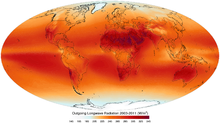- Outgoing longwave radiation
-
Not to be confused with E-rays.
Outgoing Longwave Radiation (OLR) is the energy leaving the earth as infrared radiation at low energy. OLR is a critical component of the Earth’s radiation budget and represents the total radiation going to space emitted by the atmosphere.[1] Earth's radiation balance is very closely achieved since the OLR very nearly equals the Shortwave Absorbed Radiation received at high energy from the sun. Thus, the first law of thermodynamics (energy conservation) is satisfied and the Earth's average temperature is very nearly stable. The OLR is affected by clouds and dust in the atmosphere, which tend to reduce it below clear sky values. Greenhouse gases, such as methane (CH4), nitrous oxide (N2O), water vapor (H2O) and carbon dioxide (CO2), absorb certain wavelengths of OLR adding heat to the atmosphere, which in turn causes the atmosphere to emit more radiation. Some of this radiation is directed back towards the Earth, increasing the average temperature of the Earth's surface. Therefore, an increase in the concentration of a greenhouse gas would contribute to global warming by increasing the amount of radiation that is absorbed and emitted by these atmospheric constituents.
The OLR is dependent on the temperature of the radiating body. It is affected by the earths skin temperature, skin surface emissivity, atmospheric temperature and water vapor profile, and cloud cover.[1]
References
- ^ a b Susskind, Joel; Molnar, Gyula; Iredell, Lena. "Contributions to Climate Research Using the AIRS Science Team Version-5 Products". NASA. Goddard Space Flight Center. http://hdl.handle.net/2060/20110015241. Retrieved 14 September 2011.
External links
- NOAA Climate Diagnostics Center
- NASA Earth Observatory Outgoing Heat Radiation
- Office of Satellite Data Processing and Distribution, Radiation Budget at the Wayback Machine (archived May 5, 2008)
- Meteorological Satellite Center, Japan Meteorological Agency at the Wayback Machine (archived September 27, 2007)
- Planetary Energy Balance, Physical Geography
Categories:- Climatology
- Atmospheric science stubs
Wikimedia Foundation. 2010.

